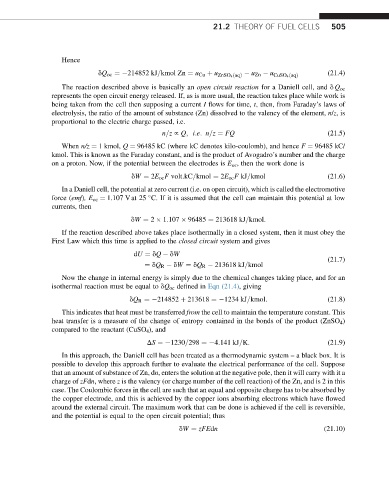Page 512 - Advanced thermodynamics for engineers
P. 512
21.2 THEORY OF FUEL CELLS 505
Hence
dQ oc ¼ 214852 kJ=kmol Zn ¼ u Cu þ u u Zn u (21.4)
ZnSO 4 ðaqÞ CuSO 4 ðaqÞ
The reaction described above is basically an open circuit reaction for a Daniell cell, and d Q oc
represents the open circuit energy released. If, as is more usual, the reaction takes place while work is
being taken from the cell then supposing a current I flows for time, t, then, from Faraday’s laws of
electrolysis, the ratio of the amount of substance (Zn) dissolved to the valency of the element, n/z,is
proportional to the electric charge passed, i.e.
n=z f Q; i:e: n=z ¼ FQ (21.5)
When n/z ¼ 1 kmol, Q ¼ 96485 kC (where kC denotes kilo-coulomb), and hence F ¼ 96485 kC/
kmol. This is known as the Faraday constant, and is the product of Avogadro’s number and the charge
on a proton. Now, if the potential between the electrodes is E oc , then the work done is
dW ¼ 2E oc F volt:kC=kmol ¼ 2E oc F kJ=kmol (21.6)
In a Daniell cell, the potential at zero current (i.e. on open circuit), which is called the electromotive
force (emf),E oc ¼ 1.107 Vat 25 C. If it is assumed that the cell can maintain this potential at low
currents, then
dW ¼ 2 1:107 96485 ¼ 213618 kJ=kmol:
If the reaction described above takes place isothermally in a closed system, then it must obey the
First Law which this time is applied to the closed circuit system and gives
dU ¼ dQ dW
(21.7)
¼ dQ R dW ¼ dQ R 213618 kJ=kmol
Now the change in internal energy is simply due to the chemical changes taking place, and for an
isothermal reaction must be equal to dQ oc defined in Eqn (21.4), giving
dQ R ¼ 214852 þ 213618 ¼ 1234 kJ=kmol: (21.8)
This indicates that heat must be transferred from the cell to maintain the temperature constant. This
heat transfer is a measure of the change of entropy contained in the bonds of the product (ZnSO 4 )
compared to the reactant (CuSO 4 ), and
DS ¼ 1230=298 ¼ 4:141 kJ=K: (21.9)
In this approach, the Daniell cell has been treated as a thermodynamic system – a black box. It is
possible to develop this approach further to evaluate the electrical performance of the cell. Suppose
that an amount of substance of Zn, dn, enters the solution at the negative pole, then it will carry with it a
charge of zFdn, where z is the valency (or charge number of the cell reaction) of the Zn, and is 2 in this
case. The Coulombic forces in the cell are such that an equal and opposite charge has to be absorbed by
the copper electrode, and this is achieved by the copper ions absorbing electrons which have flowed
around the external circuit. The maximum work that can be done is achieved if the cell is reversible,
and the potential is equal to the open circuit potential; thus
dW ¼ zFEdn (21.10)

